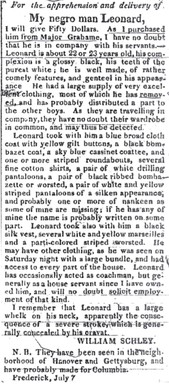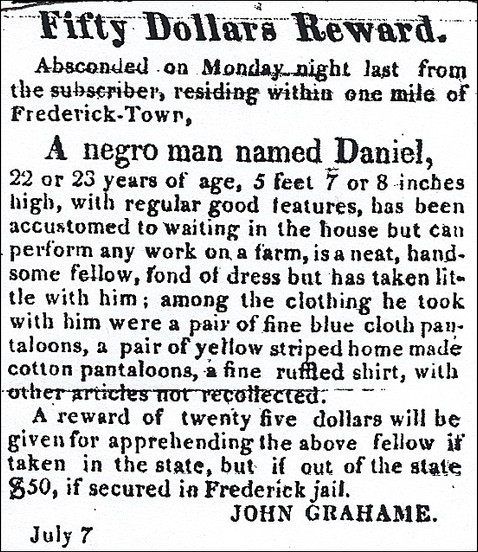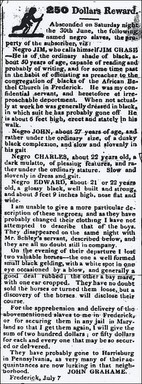The Carriage Museum
Introduction
Text-to-speech Audio
Images
Runaway Advertisement from John Grahame



Backstory and Context
Text-to-speech Audio
John Grahame was one of the Commisioners for the building of the Baltimore Frederick Turnpike which began construction in early 1800s.
One man, Leonard, who had been enslaved by John Grahame and then sold to William Schley knew these roads well as he often served as carriage driver for the Grahame family. In a notice posted in the newspaper in 1827, William Schley mentions that Leonard was occasionally the coachman, as well as being "a house servan." In 1827, Leonard along with other men enslaved by the Grahames, Jim Chase, John, Charles, Edward and Daniel sought their freedom. The notices which were posted by William Schley & John Grahame give us a description of each of these men as well as their primary work and a glimpse into their relationship with one another.
All of these men sought the opportunity for freedom rather than face being sold South as they had watched happen to a number of their family and friends over the previous few years. In light of the familial turmioal occassioned by the death of John Grahame's only son Thomas in February these six men carefully planned and timed their flight for freedom. Leonard and Daniel were noted as having positions "in the house" that would have offorded them more intimate information on the thoughts and plans dicussed by Schley and Grahame. Jim Chase was noted by John Grahame to be his "confidential servant". This intimate position, as well as, his position as a preacher for the African Bethel Church in Frederick would have provided Jim with the knowledge, rescources and connections to lay the groundwork for their flight to freedom. Between June 30th and July 2nd 1827 (on a weekend that Americans celebrate freedom) these men took their opportunity and headed for Pennsylvania.
In additon to being forced to drive their enslavers along the various roadways some enslaved individuals were forced to labor in building these roads. Moses, another man enslaved by John Grahame was sentenced in August of 1802 to a two year term in building the national road then under construction between Frederick and Baltimore. Moses had been convited of burglary by the court and was forced to labor in constructing the new national road.
The infrastructure for travel and transporation of goods on which businesses and men like John Grahame were so reliant were built by the hands, sweat and tears of enslaved and free Black people. In 1832 a cholera epidemic spread through the world and Frederick was not spared. Workers along the C&O canal and the B&O railroad brought the disease from Baltimore. Many free African Americans worked on both of these projects and went home each night to live in crowded conditions. This led to a large number of cases of cholera among free African Americans and their families in Frederick.
During the period of the property history when the Thomas family occupied the Manor house they had two free Black men, Samuel Key (1850) and Osborn Dorsey (1860) who were listed on the census records as working and living on the property. Free Black people such as Samuel Key, Osborn Dorsey, and David and Anne Robinson faced many restrictions on them related to travel and transportation. This was due to extreme fear in Maryland of the ever growing free Black population which white people felt threatened their physical safety and societal standing.
Such restrictions included:
- African Americans were banned from piloting vessels without at least one white person on board
- Permits were required to travel by train or boat and only by day
- Free Blacks not employed by a white person were required to spend one day working on public roads a year
